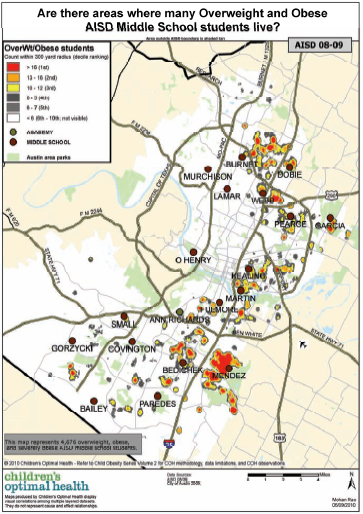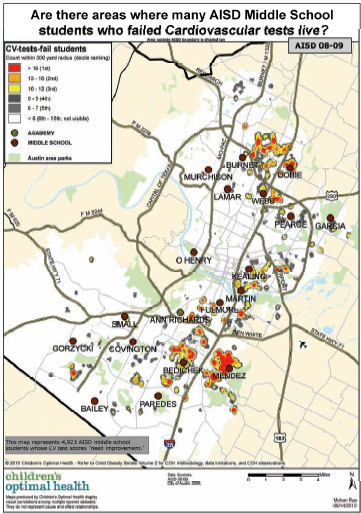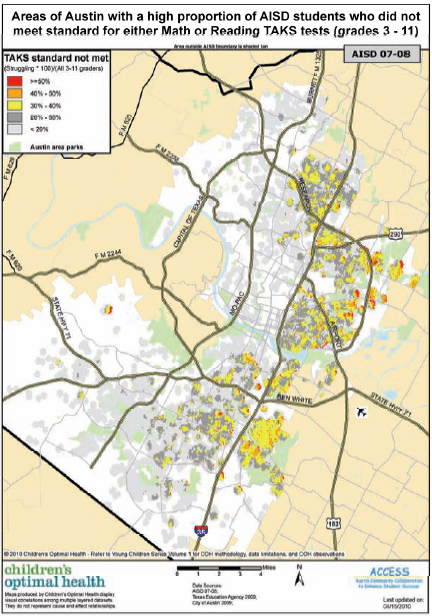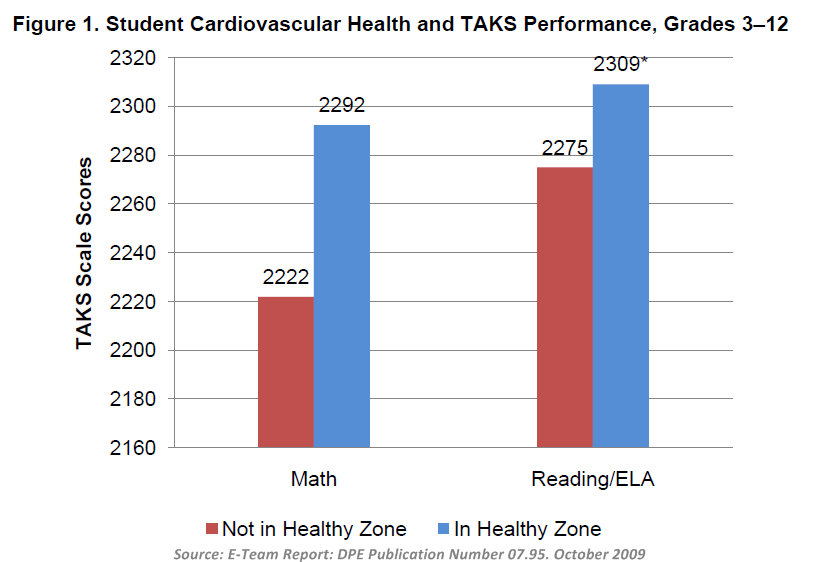Editor's Note: Twenty percent of Texas 10- to 17-year-olds are obese, according to a recent study of the nation’s obesity epidemic, placing the state seventh in the nation for this age group. All those extra pounds impose an economic burden on the state and, ultimately, the nation. Several years ago, the Texas State Comptroller reported that Texas businesses lose more than $3 billion per year in higher health care costs, absenteeism, and reduced productivity due to obesity. By 2025, those losses are expected to reach almost $16 billion.
In addition, the U.S. Department of Defense has reported that it is finding fewer recruits who are healthy candidates for the rigorous training needed to prepare them for overseas battle duty. That, potentially, is a national security issue.
The Austin Independent School District has become a key leader in the fight against childhood obesity. As Tracy Lunoff, AISD Coordinator of School Health, explains, AISD has partnered with community organizations, extending its efforts to improve student fitness and nutrition beyond the classroom, out into the neighborhoods where it is most needed.
Forefront (FF): The statistics about obesity in Texas are pretty alarming for the overall population. What is the impact for children?
Tracy Lunoff (TL): It’s a public health epidemic that is just going to continue escalating if we don’t get it under control. Obese children tend to grow into obese adults. If we want to curtail obesity in adults, we need to start with the current generation. AISD has studied the impact that obesity has on children’s ability to learn, and we realize that their future success and our overall economic future depend on the lessons and lifelong habits they acquire during their years in school.
FF: How many obese children are there within AISD?
TL:There are 16,000 overweight and obese students in AISD. Of the 16,000, approximately 2,000 are obese (99th plus percentile according to growth chart for sex and age) according to Fitnessgram assessments. These annual evaluations have shown that almost one in four Texas fourth-graders can be categorized as overweight or obese. Overweight students are in the 85th to 95th percentile for their age and sex, while obese students are in the 95th-plus percentile.
FF: What’s a Fitnessgram?
TL: Fitnessgram is a state-mandated assessment of all students in grades 3-12. It’s a six-part assessment that includes a student’s body-mass index, or BMI, cardiovascular fitness, and strength (as measured by various exercises). Every school reports the overall results to the state (Texas Education Agency) annually, and student data is shared with physical education teachers, school nurses, and parents, if they request it.
FF: What impact do Fitnessgram results have on what happens in the classroom?
TL: Overweight and obese students may have other health problems, such as diabetes, asthma, or sleep apnea, which keeps them from getting a good night’s sleep. Those conditions lead to higher absenteeism. A student who’s not in school isn’t learning. And when students are not attending, the district does not receive funding to support their education, since state reimbursements are based on attendance.
For all students, the traditional educational model is a very “neck-up” approach, while obesity is a “whole-child” condition. What affects the body affects the mind and learning. In fact, we’ve found through research and data analysis of students’ Fitnessgram data and TAKS performance data that overweight and obese students, particularly those with poor cardiovascular fitness, do not score as well on the standardized math and reading TAKS tests as do students who are more physically fit.
FF: That’s a bold claim. How do you know this?
TL: Research internally and externally has been conducted, and the data supports it.
We partnered with Children’s Optimal Health to use GIS mapping technology that overlays our Fitnessgram data with school zones and zip codes to see where the problems were most acute. That data showed us where overweight and obese students live (Map A), and where students who had not performed in the healthy fitness zone for the cardiovascular tests live (Map B).
MAP A

MAP B

When you then look at the geographic distribution of poor TAKS tests performance, the correlation is striking.(Map C),
MAP C

FF: So that shows geographic correlation. Can you translate that into the classroom?
TL: We were able to see the next piece of the puzzle when we partnered with the UT School of Public Health to study the relationship between student health and academic achievement across the district. We were able to isolate the variables of cardiovascular fitness and of being economically disadvantaged. In both cases, there’s a significant relationship. But what really stood out was that all of our students could do better if they were more fit. The fittest students performed better overall on TAKS, in reading, and most particularly in math (Fig. 1).

FF: So what is AISD doing to promote student fitness?
TL: Dr. Carstarphen and her senior cabinet believe in educating the “whole child.” We’ve instituted programs in the district, on campuses, in the classroom, in the cafeteria, and in the community. This coordinated effort is our focus for addressing the issue of childhood obesity.
First, as mandated by state law, every campus in grades K-8 implements a program called CATCH or Coordinated Approach to Child’s Health. The CATCH initiative is a collaborative effort linking health education, physical education, nutrition, the Food Services Department, parents, and the community. This comprehensive program promotes physical activity and healthy food choices for elementary school students, their families, and their communities, not just in Austin but also throughout Texas.
Additionally, it’s been shown for both students and adults that short bursts of physical activity get brain synapses firing and can be as effective as running for 30 to 60 minutes in improving mental acuity. So we’ve implemented opportunities for “brain breaks” for students and faculty as part of the curriculum. Programs like HOPSports are a big hit with today’s tech-savvy students. HOPSports projects an image of an athlete or celebrity - LeBron James dribbling a basketball, for example- for students to imitate in a five-minute brain break in the classroom, to get active and engaged before they sit down. We even implement these brain breaks during staff meetings, and even during our general administrative meetings with principals
FF: What about in the cafeteria?
TL: We’ve made a heaping plateful, so to speak, of nutritional and environmental improvements. We replaced carbonated beverages in our student-accessible vending machines with water, 100% fruit juice, and skim milk. Chef Steven has created nutritious recipes that are pleasing to our students’ fast-food palates, such as pizza made with whole-wheat flour, low-fat cheese, and turkey pepperoni. We’ve introduced whole-grain brown rice in our Asian dishes, and have introduced pasta with omega-3 fatty acids included. We offer fresh fruits and vegetables every day, including some you might not expect, such as edamame. The kids love it. Yes, there are french fries too, but they’re actually baked potato wedges with about half a gram of fat.
FF: So that ensures two nutritious meals a day, at breakfast and lunch. But you have them for just seven hours a day. What happens when they leave?
TL: Through the CATCH program, the parent component educates parents and increases their awareness about preparing nutritious meals that are also cost-effective. Second, referring to our study with Children’s Optimal Health, we were able to use those maps to initiate conversations within the neighborhoods, to partner with local entities to provide services and resources. These may include programs in faith-based or community centers to encourage parents to prepare more nutritious meals at home, or partnering with the Texas AgriLife Extension Agency to offer cooking and nutrition classes to parents on campuses for free in Spanish and English. Our list of partnerships is extensive. We have many partners working within the district to assist parents with health and nutrition information and awareness.
And when the maps identify an area with a high crime rate, we can use the maps to talk with the police department about how intensified efforts to reduce crime can encourage children to play outdoors, improving their physical fitness.
FF: Can you measure the impact that all of these programs are having on the students?
TL: We can measure the impact. Included in our district’s strategic plan, we have goals, objections, and key action items that specifically relate to addressing the obesity epidemic. Seeing results takes time, but TAKS test scores are one way to measure progress. So are lower numbers of overweight and obese students in our Fitnessgram evaluations. Improvements in both areas will demonstrate the value of our programs to encourage better fitness and nutrition.
Ultimately, the Austin school district’s goal is to produce educated citizens capable of contributing to the economic well-being of our region. That’s why the issue of childhood obesity is something none of us - the school system, the family, or the community - can afford to ignore. These children are at a competitive disadvantage now, when they perform poorly on our system’s standardized tests. As they mature, if they continue to lag behind in society’s measures of success, such as earning capacity and productivity, our society as a whole will bear the cost.
Learn More

|










